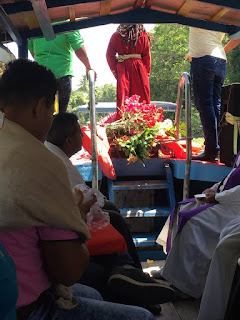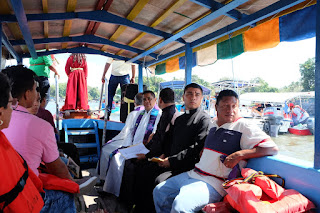 |
| Via Crucis Aquatic, Granada Nicaragua |
The Via Crucis, or Way of the Cross, is the series of images (usually 14) showing Jesus on the day of his crucifixion, along with the related prayers. During the period of Lent and, particularly, on Good Friday there are many Via Crucis processions in Latin American countries. Typically, stations portraying the stations will be set up along streets and pilgrims walk between stations, stopping at each for specific prayers and benedictions. For those of you that are unfamiliar with this ritual, please click this link for more in-depth information- https://en.wikipedia.org/wiki/Stations_of_the_Cross
Granada, Nicaragua has a totally unique form of the Via Crucis that is performed on the water in small boats and know as Via Crucis Aquatic; it is the only place in Latin America where this is done. This aquatic Viacrucis happens on Cocibolca (Lake Nicaragua), the largest lake in Central America and is occurs a few times in the week preceding Easter. Hotels and tourist information cannot tell you when they are because there is no set schedule for them. I was advised to go and inquire at Guadalupe Church, which hosts processions, to find a time and possibly get a ticket.
 |
| Guadalupe Church, Granada Nicaragua |
The day I went to Guadalupe church, I was lucky, because the office was open and I speak enough Spanish to explain what I was wanted. I paid a nominal fee and was handed this ticket.
 |
| Via Crucis Aquatic ticket |
As I later discovered, I had hit the jackpot without knowing it. The ticket was for the Wednesday before Easter on the lead boat, the one carrying the holy image (imagen) of Jesus Nazareno. Commercial tours that offer the Via Crucis Aquatic, put tourists in boats that follow the actual water-borne religious procession, but this little purple ticket placed me square in the midst of the procession on the lead boat. Most tourists, if they are lucky, find a boat from which to observe the procession; being a part of the procession, as I was, was totally different.
You will notice that the time listed on the ticket was 6:30 am, which meant that I had to be at Guadalupe Church early Wednesday morning. From there the group, mostly congregation members, boarded a van to the lake and our boat.
 |
| In van, on the way to the Via Crucis Aquatic |
Lake Nicaragua, Cocibolca, is a huge body of water with an outlet to the Atlantic
Granada is located on its shore and in it are 365 small islands (Islets of Granada) located just southeast of the city of Granada; many of them are inhabited either on a full-time or part-time vacation basis. Lake Nicaragua is the largest lake in Central America.
 |
| Cocibolca, (Lake Nicaragua), Granada Nicaragua |
A band that would play during the Viacrucis procession was already loaded on board and everyone was handed a life jacket for the duration of the nearly 6 hour journey, that would include no bathroom breaks!
 |
| Boat readied for Via Crucis Aquatic, Granada Nicaragua |
 |
| Band instruments on board boat for Via Crucis Aquatic procession, Granada Nicaragua |
Below, other boats are loading passengers before taking their place in the procession.
 |
| Boats loading for Via Crucis Aquatic, Granada Nicaragua |
Because ours was the lead boat, the boat carrying the religious image, members of the clergy came on board to conduct the service.
 |
| Clergy on board lead boat, Via Crucis Aquatic, Granada Nicaragua |
The boat took off without a statue and at the first island stop, a statue of Jesus Nazareno, the imagen or image referred to on my ticket, was taken from a small chapel where it had been and loaded onto the front of our boat to lead the procession and remain there until the Viacrucis was over hours later. In Latin America significant statues are sometimes lent among churches in a kind of solemn interchange.
 |
| Image of Jesus Nazareno being loaded onto Via Crucis Aquatic boat, Granada Nicaragua |
 |
| Jesus Nazarene aboard Via Crucis Aquatic, Granada Nicaragua |
Here is a photo of me on the boat as the event gets underway; how I managed to have the luck to get on this boat I still do not know.
 |
| Author aboard in Via Crucis Aquatic, Granada Nicaragua |
The boats in the procession made 14 stops, one for each of the stations of the Cross, each time pulling up at another of the tiny islands, the isletas, that dot Lake Nicaragua. At each stop, after the prayers, people offered flowers and fruit to image of Jesus. These offerings were absolutely beautiful and rapidly filled the boat's floor.
 |
| Offerings, Via Crucis Aquatic, Granada Nicaragua |
The band played frequently throughout the event, often when approaching or leaving a station. Their music consisted of the funeral marches typical of the area. These, during the colonization of Latin America, were adapted to military bands that accompanied funerals and so in addition to being sombre have a military feeling as well. They are of a specific musical genre having initially been written by composers with very little musical training.
 |
| Band playing during Via Crucis Aquatic, Granada Nicaragua |
There were two kinds of boats out on Cocibolca that day, boats participating in the procession and sight-seeing boats following the processional boats. Below are some of the many tour boats, since the event is a popular one for tourists. Observing the procession and being a part of it are two entirely different things.
 |
| Tourist Boats during Via Crucis Aquatic, Lake Nicaragua |
Each Station of the Cross had been carefully decorated by the inhabitants of the various islands.
 |
| Station of the Cross, Via Crucis Aquatic, Granada Nicaragua |
 |
| Station of the Cross, Via Crucis Aquatic, Granada Nicaragua |
 |
| Station of the Cross, Via Crucis Aquatic, Granada Nicaragua |
 |
| Station of the Cross, Via Crucis Aquatic, Granada Nicaragua |
 |
| Station of the Cross, Via Crucis Aquatic Granada Nicaragua |
 |
| Station of the Cross, Via Crucis Aquatic, Granada NIcaragua |
 |
| Station of the Cross, Via Crucis Aquatic, Granada Nicaragua |
 |
| Station of the Cross, Via Crucis Aquatic, Granada Nicaragua |
As the procession went along the boat became more and more laden with the offerings that were given by the islanders at each stop. Some people donated money to the church and there was a designated person onboard to collect it. At the end of the Via Crucis some of the fruit was sold to people on the boat who wanted it and some remained for the church and clergy and to be distributed among the needy.
 |
| Flower Offering, Via Crucis Aquatic, Granada Nicaragua |
 |
| Fruit Offering, Via Crucis Aquatic, Granada Nicaragua |
 |
| Fruit Offering, Via Crucis Aquatic, Granada Nicaragua |
 |
| Floral Offering, Via Crucis Aquatic, Granada Nicaragua |
At the Via Crucis' end, the statue of Jesus was removed from the boat, to be returned
to its "home" church in the city.
 |
| Jesus Nazareno about to be removed from Via Crucis Aquatic boat, Granada Nicaragua |
Reflections:
All Via Crucis are solemn devotional events, but Granada's Via Crucis Aquatic is more than just that. It is not only an opportunity for personal devotion for participants, but an celebration that unites Granada and its outlying islands, giving the community a chance to come together in an activity that has meaning for all. It is a solemn celebration, but also one with much beauty and its own sort of joy. Money is raised for the church and some of the offerings are donated to the needy.
The Via Crucis Aquatic is a unique experience, and a local mainstay of Holy Week in Granada. It is offered as a highlight on all tours to the area, even though tourists are advised that there is a chance one may not be available on the day or days they are there.
I plan on making a video of the Via Crucis Aquatic in the near-future.























































